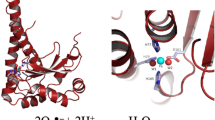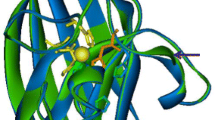Abstract
A recombinant hybrid of manganese dependent-superoxide dismutase of Staphylococcus equorum and S. saprophyticus has successfully been overexpressed in Escherichia coli BL21(DE3), purified, and characterized. The recombinant enzyme suffered from degradation and aggregation upon storage at −20 °C, but not at room temperature nor in cold. Chromatographic analysis in a size exclusion column suggested the occurrence of dimeric form, which has been reported to contribute in maintaining the stability of the enzyme. Effect of monovalent (Na+, K+), divalent (Ca2+, Mg2+), multivalent (Mn2+/4+, Zn2+/4+) cations and anions (Cl−, SO4 2−) to the enzyme stability or dimeric state depended on type of cation or anion, its concentration, and pH. However, tremendous effect was observed with 50 mM ZnSO4, in which thermostability of both the dimer and monomer was increased. Similar situation was not observed with MnSO4, and its presence was detrimental at 200 mM. Finally, chelating agent appeared to destabilize the dimer around neutral pH and dissociate it at basic pH. The monomer remained stable upon addition of ethylene diamine tetraacetic acid. Here we reported unique characteristics and stability of manganese dependent-superoxide dismutase from S. equorum/saprophyticus.




Similar content being viewed by others
Abbreviations
- EDTA:
-
Ethylene diamine tetra acetate
- LC–MS/MS:
-
Liquid chromatography tandem mass spectrometry
- ORF:
-
Open reading frame
- PAGE:
-
Polyacrylamide gel electrophoresis
- rMnSODSeq:
-
Recombinant hybrid manganese superoxide dismutase from S. saprophyticus/S. equorum
- SDS:
-
Sodium dodecyl sulphate
- SO:
-
Superoxide
- SOD:
-
Superoxide dismutase
- T m :
-
Melting temperature
- T mD :
-
Melting temperature of dimer
- T mM :
-
Melting temperature of monomer
References
McCord JM, Fridovich I (1969) Superoxide dismutase, an enzymic function for erythrocuprein (hemocuprein). J Biol Chem 244(22):6049–6055
Halliwell B (1994) Free radicals, antioxidants, and human disease: curiosity, cause, or consequence? Lancet 344(8924):721–724. doi:10.1016/s0140-6736(94)92211-x
Maritim AC, Sanders RA, Watkins JB (2003) Diabetes, oxidative stress, and antioxidants: a review. J Biochem Mol Toxicol 17(1):24–38
Choi J, Rees HD, Weintraub ST, Levey AI, Chin LS, Li L (2005) Oxidative modifications and aggregation of Cu, Zn-superoxide dismutase associated with alzheimer and parkinson diseases. J Biol Chem 280(12):11648–11655
Yasui K, Baba A (2006) Therapeutic potential of superoxide dismutase (SOD) for resolution of inflammation. Inflamm Res 55:359–363
Lods LM, Dres C, Johnson C, Scholz DB, Brooks GJ (2000) The future of enzymes in cosmetics. Int J Cosmet Sci 22:85–94
Indrayati A, Asyarie S, Suciati T, Retnoningrum DS (2014) Study on the properties of purified recombinant superoxide dismutase from Staphylococcus equorum, a local isolate from Indonesia. Int J Pharm Pharm Sci 6(11):1–6
Seatovic S, Gligic L, Radulovic E, Jankov RM (2004) Purification and partial characterization of superoxide dismutase from the thermophilic bacteria Thermothrix sp. J Serb Chem Soc 69(1):9–16
Areekit S, Kanjanavas P, Khawsak P, Pakpitchareon A, Potivejkul K, Chansiri G, Chansiri K (2011) Cloning, expression, and characterization of thermotolerant manganese superoxide dismutase from Bacillus sp. MHS47. Int J Mol Sci. doi:10.3390/ijms12010844
Ken C-F, Lee C-C, Duan K-J, Lin C-T (2005) Unusual stability of manganese superoxide dismutase from a new species, Tatumella ptyseos ct: its gene structure, expression, and enzyme properties. Protein Expr Purif 40(1):42–50
Wang W, Ma T, Zhang B, Yao N, Li M, Cui L, Li G, Ma Z, Cheng J (2014) A novel mechanism of protein thermostability: a unique N-terminal domain confers heat resistance to Fe/Mn-SODs. Sci Rep 4:1–9
Li D, Gao J, Li Y, Lu J (2005) A thermostable manganese-containing superoxide dismutase from the thermophilic fungus Thermomyces lanuginosus. Extremophiles 9(1):1–6
Wang X, Yang H, Ruan L, Liu X, Li F, Xu X (2008) Cloning and characterization of a thermostable superoxide dismutase from the thermophilic bacterium Rhodothermus sp. XMH10. J Ind Microbiol Biotechnol 35(2):133–139
Zhu Y, Li H, Zhang X, Zhang C, Xiang J, Liu G (2011) Characterization of a thermostable manganese-containing superoxide dismutase from inshore hot spring thermophile Thermus sp. JM1. Acta Oceanol Sin 30(6):95–103
Song C, Sheng L, Zhang X (2012) Preparation and characterization of a thermostable enzyme (Mn-SOD) immobilized on supermagnetic nanoparticles. Appl Microbiol Biotechnol 96(1):123–132. doi:10.1007/s00253-011-3835-9
Miller A (2004) Superoxide dismutases: active sites that save, but a protein that kills. Curr Opin Chem Biol 8(2):162–168
Wuerges J, Lee J-W, Yim Y-I, Yim H-S, Kang S-O, Carugo KD (2004) Crystal structure of nickel-containing superoxide dismutase reveals another type of active site. Proc Natl Acad Sci USA 101(23):8569–8574. doi:10.1073/pnas.0308514101
Borgstahl G, Parge H, Hickey M, Beyer W, Hallewell R, Tainer J (1992) The structure of human mitochondrial manganese superoxide dismutase reveals a novel tetrameric interface of two 4-helix bundles. Cell 71(1):107–118. doi:10.1016/0092-8674(92)90270-M
Breusegem FV, Slooten L, Stassart J-M, Moens T, Botterman J, Montagu MV, Inze D (1999) Overproduction of Arabidopsis thaliana Fe-SOD confers oxidative stress tolerance to transgenic maize. Plant Cell Physiol 40(5):515–523
Abreu IA, Cabelli DE (2010) Superoxide dismutases—a review of the metal-associated mechanistic variations. Biochim Biophys Acta 1804:263–274
Liu J, Yin M, Zhu H, Lu J, Cui Z (2011) Purification and characterization of a hyperthermostable Mn-superoxide dismutase from Thermus thermophilus HB27. Extremophiles 15(2):221–226
Song C, Li H, Sheng L, Zhang X (2015) Characterization of the interaction between superoxide dismutase and 2-oxoisovalerate dehydrogenase. Gene 568(1):1–7
Indrayati A (2011) 16S rDNA Based identification of novel superoxide dismutase producing bacteria isolate from Indonesia. Microbiol Indones 5(2):88–93
Ghebremedhin B, Layer F, König W, König B (2008) Genetic classification and distinguishing of Staphylococcus sp. based on different partial gap, 16S rRNA, hsp60, rpoB, sodA, and tuf gene sequences. J Clin Microbiol 46(3):1019–1025. doi:10.1128/JCM.02058-07
Gasteiger E, Hoogland C, Gattiker A, Duvaud S, Wilkins MR, Appel RD, Bairoch A (2005) Protein identification and analysis tools on the ExPASy server. In: Walker JM (ed) The proteomics protocols handbook. Humana Press, New York, pp 571–607
Bradford MM (1976) Rapid and sensitive method for the quantitation of microgram quantities of protein utilizing the principle of protein-dye binding. Anal Biochem 72:248–254. doi:10.1016/0003-2697(76)90527-3
Schneider CA, Rasband WS, Eliceiri KW (2012) NIH image to imageJ: 25 years of image analysis. Nat Methods 9:671–675
Shevchenko A, Wilm M, Vorm O, Mann M (1996) Mass spectrometric sequencing of proteins from silver-stained polyacrylamide gels. Anal Chem 68(5):850–858. doi:10.1021/ac950914h
Sun Y, Oberley LW, Li L (1988) A simple method for clinical assay of superoxide dismutase. Clin Chem 34(3):497–500
Kimoto R, Funahashi T, Yamamoto N, Miyoshi S, Narimatsu S, Yamamoto S (2001) Identification and characterization of the sodA genes encoding manganese superoxide dismutases in Vibrio parahaemolyticus, Vibrio mimicus, and Vibrio vulnificus. Microbiol Immunol 45(2):135–142
Yainoy S, Isarankura-Na-Ayudhya C, Tantimongcolwat T, Prachayasittikul V (2007) Cloning of active human manganese superoxide dismutase and its oxidative protection in Escherichia coli. Pak J Biol Sci 10(20):3541–3548
Kostyuk VA, Potapovich AI, Strigunova EN, Kostyuk TV, Afanas’ev IB (2004) Experimental evidence that flavonoid metal complexes may act as mimics of superoxide dismutase. Arch Biochem Biophys 428:204–208
Ericsson U, Hallberg B, Detitta G, Dekker N, Nordlund P (2006) Thermofluor-based high-throughput stability optimization of proteins for structural studies. Anal Biochem 357(2):289–298
Gaupp R, Ledala N, Somerville GA (2012) Staphylococcal response to oxidative stress. Front Cell Infect Microbiol 2:33. doi:10.3389/fcimb.2012.00033
McWilliam H, Li W, Uludag M, Squizzato S, Park Y, Buso N, Cowley A, Lopez R (2013) Analysis tool web services from the EMBL-EBI. Nucleic Acids Res 41:W597–W600
Barrière C, Brückner R, Talon R (2001) Characterization of the single superoxide dismutase of Staphylococcus xylosus. Appl Environ Microbiol 67(9):4096–4104. doi:10.1128/AEM.67.9.4096-4104.2001
Tanghe A, Dijck PV, Thevelein JM (2003) Determinants of freeze tolerance in microorganisms, physiological importance, and biotechnological applications. Adv Appl Microbiol 53:129–176
Dawson NJ, Katzenback BA, Storey KB (2015) Free-radical first responders: the characterization of CuZnSOD and MnSOD regulation during freezing of the freeze-tolerant North American wood frog Rana sylvatica. Biochim Biophys Acta 1850(1):97–106. doi:10.1016/j.bbagen.2014.10.003
McKersie B, Chen Y, de Beus M, Bowley S, Bowler C, Inzé D, D’Halluin K, Botterman J (1993) Superoxide dismutase enhances tolerance of freezing stress in transgenic alfalfa (Medicago sativa L.). Plant Physiol 103(4):1155–1163
Abreu IA, Hearn A, An H, Nick HS, Silverman DN, Cabelli DE (2008) The kinetic mechanism of manganese-containing superoxide dismutase from Deinococcus radiodurans: a specialized enzyme for the elimination of high superoxide concentrations. Biochemistry 47:2350–2356
Søndergaard A, Stahnke L (2002) Growth and aroma production by Staphylococcus xylosus, S. carnosus and S. equorum—a comparative study in model systems. Int J Food Microbiol 75(1–2):99–109
Chan C, Wilbanks C, Makhatadze G, Wong K (2012) Electrostatic contribution of surface charge residues to the stability of a thermophilic protein: benchmarking experimental and predicted pKa values. PLoS One 7(1):e30296. doi:10.1371/journal.pone.0030296
Horovitz A, Serrano L, Avron B, Bycroft M, Fersht AR (1990) Strength and co-operativity of contributions of surface salt bridges to protein stability. J Mol Biol 216(4):1031–1044
Sancho J, Serrano L, Fersht AR (1992) Histidine residues at the N- and C-termini of. alpha.-helixes: perturbed pKas and protein stability. Biochemistry 31(8):2253–2258. doi:10.1021/bi00123a006
Sheng Y, Stich TA, Barnese K, Gralla EB, Cascio D, Britt RD, Cabelli DE, Valentine JS (2011) Comparison of two yeast MnSODs: mitochondrial Saccharomyces cerevisiae versus cytosolic Candida albicans. J Am Chem Soc 133:20878–20889
Sheng Y, Durazo A, Schumacher M, Gralla EB, Cascio D, Cabelli DE, Valentine JS (2013) Tetramerization reinforces the dimer interface of MnSOD. PLoS One 8(5):e62446. doi:10.1371/journal.pone.0062446
Lin C-T, Lin M-T, Chen Y-T, Shaw J-F (1995) Subunit interaction enhances enzyme activity and stability of sweet potato cytosolic Cu/Zn-superoxide dismutase purified by a His-tagged recombinant protein method. Plant Mol Biol 28(2):303–311
Whittaker MM, Whittaker JW (1998) A glutamate bridge is essential for dimer stability and metal selectivity in manganese superoxide dismutase. J Biol Chem 273(35):22188–22193. doi:10.1074/jbc.273.35.22188
Edwards RA, Whittaker MM, Whittaker JW, Baker EN, Jameson GB (2001) Removing a hydrogen bond in the dimer interface of Escherichia coli manganese superoxide dismutase alters structure and reactivity. Biochemistry 40(15):4622–4632. doi:10.1021/bi002403h
Trinh CH, Hunter T, Stewart EE, Phillips SEV, Hunter GJ (2008) Purification, crystallization and X-ray structures of the two manganese superoxide dismutases from Caenorhabditis elegans. Acta Crystallogr F 64(12):1110–1114. doi:10.1107/S1744309108037056
Borgstahl GEO, Parge HE, Hickey MJ, Johnson MJ, Boissinot M, Hallewell RA, Lepock JR, Cabelli DE, Tainer JA (1996) Human mitochondrial manganese superoxide dismutase polymorphic variant Ile58Thr reduces activity by destabilizing the tetrameric interface. Biochemistry 35(14):4287–4297. doi:10.1021/bi951892w
Desmet J, Joniau M, Hv Dael (1992) The effect of metal ion binding on protein stability. In: Tweel WJJvd, Harder A, Buitelaar RM (eds) Stability and stabilization of enzymes. Elsevier Science Publisher BV, Maastricht, pp 299–308
Whittaker JW (2003) The irony of manganese superoxide dismutase. Biochem Soc Trans 31(6):1318–1321
Acknowledgments
This work is financially supported by Program Riset Desentralisasi DIKTI 2013 and Program Riset Inovasi 2015.
Author information
Authors and Affiliations
Corresponding author
Electronic supplementary material
Below is the link to the electronic supplementary material.
Rights and permissions
About this article
Cite this article
Retnoningrum, D.S., Rahayu, A.P., Mulyanti, D. et al. Unique Characteristics of Recombinant Hybrid Manganese Superoxide Dismutase from Staphylococcus equorum and S. saprophyticus . Protein J 35, 136–144 (2016). https://doi.org/10.1007/s10930-016-9650-5
Published:
Issue Date:
DOI: https://doi.org/10.1007/s10930-016-9650-5




